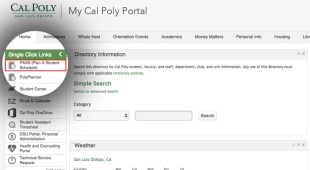- It’s a two-step process.
When entering the registration process at Cal Poly San Luis Obispo, it is important to understand the two parts of the process: completing Poly Planner and then finalizing your PASS (Plan a Student Schedule). Poly Planner is a wa
http://www.csmadvising.calpoly.edu
y for the school to gage how many people are interested in taking certain classes. It is also helpful for students to figure out which classes they prefer to be enrolled in as well. PASS is the second step in registering for courses. On PASS, students can form a rough schedule of the classes they wish to take and the days and times they wish to take those courses. https://my.calpoly.edu/cas/login?service=https://myportal.calpoly.edu/Login However, there is an untold third step in this process…remain calm! As stressful and difficult this process may be, it is essential to recognize that every other student is in the same boat.
2. When the time comes, be ready.
Each student is assigned a registration time slot depending on what year they are and their last name (often times seniors have the privilege of registering before freshman). Once you have successfully filled out Poly Planner and PASS, you must wait for your assigned registration date. When the time comes, as quickly as you can, send your schedule through to the Student Center. The faster you do it, the more likely chance you have of being enrolled in your preferred courses.
3. Classes fill up. Here are 5 steps you can take when the door closes.
The first step in grappling with registration nightmare is to get on the waitlist as soon as possible. Often times students who successfully registered for a certain course, will end up dropping that course and adding an alternative one for a variety of reasons. The second and third steps include consulting the professor or the registrar. Communication is key in the registration process. The fourth step is exploring other options and alternatives. It is important to not be fixated on a getting into a particular course. Keep an open mind. Some classes may be more interesting and helpful than you may think. Finally, the fifth and final step is to formulate a back-up plan. Be creative with your options. An alternative plan will relieve your stress and provide a solution in case your original plan doesn’t work out. http://collegelife.about.com/od/academiclife/a/WhatToDoIfAClassIsFull.htm
4. Why are some classes harder to enroll in than others?
Popularity. Some courses happen to be appealing to most people which is why the spots for those classes are full immediately. Another reason is that most students attempt to take courses that they will succeed in and fit their their strengths academically. For example, most liberal arts students wouldn’t choose to take Calculus or Chemistry to fulfill their General Education requirements for science and math. Instead they might take psychology which is considered to be more of a “soft science.”
5. Crashing courses. 
Many students don’t bother “sitting in” on a course because they assume if the course is full, nobody will be added. This is often times not the case. Professors will most times allow students to join the class if they show up on the first day and express interest.
ii.library.jhu.edu
6. Do students struggle with registration at other Universities in the U.S.?
State Universities are known to be the most impacted, making it particularly difficult to enroll in the number of units to be considered a “full-time student.” http://www.nytimes.com/2010/01/24/education/24sfstudent.html Compared to other universities, such as private colleges and community colleges, it is less difficult to get the units necessary to graduate on time.
7. What resources are available in helping students choose courses and enroll?
There are a variety of resources available to help students navigate the process of registering. One of these resources in the Mustang Success Center which provides first and second year students, transfer students, and student-athletes with effective advising services and workshops that will help students understand the policies and procedures of Cal Poly. At the Mustang Success Center, advisors will also refer students to appropriate campus resources. Each College has an admission center where experts will help you organize and make adjustments to your Poly Planner. In each dorm a Coordinator of Student Development (CDA) is readily available to answer any questions or refer you to other resources located on campus as well. https://afd.calpoly.edu/hr/


mustangnews.net
8. What are the consequences of not being enrolled in enough units to be considered a full-time student?
At Cal Poly, if you are a freshman not enrolled in at least 12 units, you can potentially be asked to move out of the dorms. If you are not a freshman, it is less of a problem, however, you may fall behind and have to return for another quarter or fifth year depending on how many units you still need to graduate. This poses financial issue because the more quarters you add, the more money you pay.
9. Graduating on time-realistic or not?
According to the Department of Education, fewer than 40% of students who enter college each year graduate within four years. http://business.time.com/2013/01/10/the-myth-of-the-4-year-college-degree/ Overcrowded classes can make it impossible for students to fulfill degree requirements in a timely manner. This is not only an issue of time, but more importantly a financial issue for most students. College is known to be overtly expensive, which makes graduating on time a major stressor for students and their families.
10. Is paying for an extra year or two of school worth it in the long run?
In the fall of 2015, there were roughly 55,000 applicants to Cal Poly San Luis Obispo and about 5,000 students were admitted. For a freshman class, 5,000 students is a large amount compared to other universities which means it is inevitable to have trouble getting the classes needed to graduate in four years. However the statistics of being employed after graduating from Cal Poly make it more worthwhile. The percent of graduates that are employed full-time or in graduate school within one year of graduation is 80 percent. Taking this into consideration can put the future into perspective for many students.